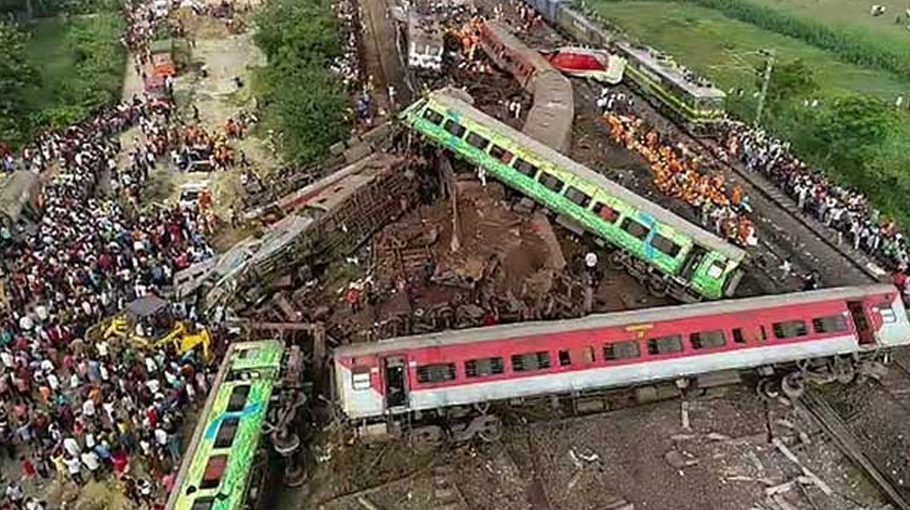India’s train accident leaves many unanswered questions
We must try to reflect upon what really went wrong in the Odisha rail tragedy

The callousness was heart wrenching to see. Dead bodies were being flung carelessly into an open truck, piled one on top of the other in a stark reminder that in India life is not just cheap but it can also be stripped off all dignity.
The images brought back flashes of the second Covid wave where even in death there was no respect. Yet we are a nation that is in a hurry to move on. At least two people including a young boy were found alive from under the mountain of bodies.
In the deadliest train collision in the country almost 300 people died in Odisha’s Balasore when three trains- two passenger and one freight, collided. Signalled to enter the loop line, Coromandel Express rammed into a stationary freight train already in position causing multiple coaches to derail in the opposite direction. The tragedy was compounded when an incoming Howrah Express ploughed into the strewn bogeys at high-speed leading to unmitigated disaster.
Unveiling the devastation in Odisha
For hundreds of passengers, it was over in a matter of minutes. Among them was a family who had boarded the Coromandel Express in hope, they were going to Chennai for medical treatment of a family member. Even that fighting chance was taken away from them.
Survivors of a tragedy of this magnitude have stories and scars. Some will never forget how they changed a seat and lived to tell the tale; others will find it difficult to sleep without remembering the panic-stricken woman desperately searching for her child in the mangled coaches.
India’s people, still clinging to faith in humanity despite being
repeatedly defeated by the system. Locals were the first
respondents at the accident site, later queuing up in large
numbers at hospitals to give blood to the injured. 100 bodies
are still to be identified but the trains are back, crisscrossing Balasore
One of those fortunate enough to come out physically unscathed, Anubhav Das, a PhD student told me how death hung in the air. “It had become dark, and we were using our phone lights which meant we couldn’t see too far ahead. Suddenly I came across a severed head in the debris. Moments later a boy of about 18 years of age came towards me for help, he had deep cuts on his forehead, and it had affected his eye as he was bleeding profusely. He was carrying an older man who looked to be his father, the man had a severed arm.” Das admits the mental recovery from the trauma will take time.
These survivors also have questions. Why did 300 co-passengers not make it to their destination? Does India need shiny railway stations that mimic airports when it continues to be the lifeline of the poor and lower middle class whose safety is a roll of dice?
Disasters in India are usually followed by a set pattern. Investigation teams and committees are formed and what should have been dealt with as a peremptory act is tackled post haste.
A cross migration in motion India’s rail network is the third largest in the world and amongst the busiest with 13,000 trains crisscrossing daily, a cross migration in motion. Nevertheless, even a single accident is one too many.
“Number of trains must be reduced to let the system recoup,” says Sarabjit Singh, former general manager, Indian railways. He adds, “systems need to match technology, but the issue is not technical it is in a way political for it is up to the minister to say no more trains and cutting back on some that already exist.”
A report from the Comptroller and Auditor General (CAG) tabled in Parliament flagged the decline in funds allocated in the last five years for track renewal with even the depleted funding under-utilised.
This despite lack of track maintenance causing most of the major accidents in the past few years. Only Rs20.74 crore out of the total expenditure of Rs689.90 crore were used for track renewal on Western Railway in 2019-2020. That is mere 3% of the funds.
Large-scale devastation
As you go in deeper, it becomes more casual, railway vacancy in 300,000 posts remains unfilled and the indigenously made anti- train collision system “Kavach” that has been in the works since 2011 has only been introduced on less than four per cent of railway routes, Balasore not included.
India’s march as a global leader is derailed by disasters like these. In a nod to how seriously we take our place in the world, hours later a four-lane under construction bridge over the river Ganga collapsed in the state of Bihar, for the second time in fourteen months.
Last year the Morbi suspension bridge folded up in Gujarat plunging hundreds into the river below. 9 people were arrested including two ticketing clerks and three security guards. Demands for a CBI enquiry and whispers of a sabotage after the train accident are once again setting up for the unsuspecting to be the
fall guy.
India’s people, still clinging to faith in humanity despite being repeatedly defeated by the system. Locals were the first respondents at the accident site, later queuing up in large numbers at hospitals to give blood to the injured. 100 bodies are still to be identified but the trains are back, crisscrossing Balasore.
Jyotsna Mohan is the author of the investigative book ‘Stoned, Shamed, Depressed’. She was also a journalist with NDTV for 15 years.
Source: Gulf News




